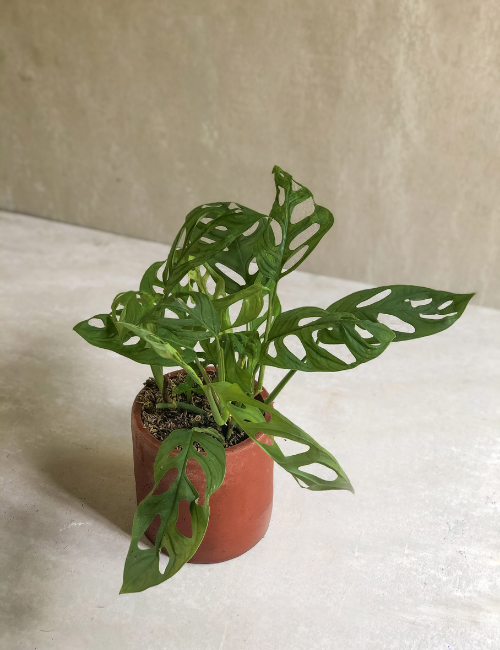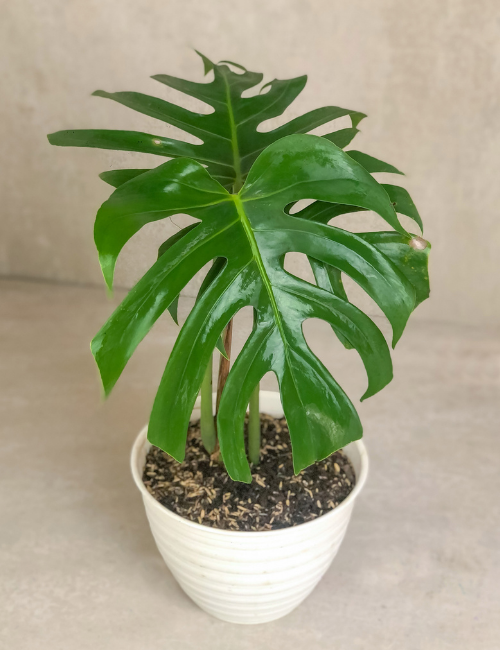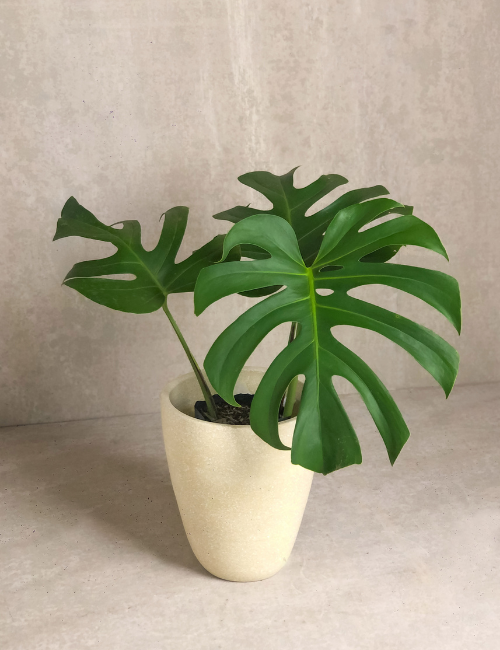-
 Monstera Adansonii in Terracotta. The Swiss cheese plant, Monstera Adansonii, gets its name from its large, heart-shaped leaves, and as the plant ages, the leaves develop holes (called fenestration) that makes the leaves resemble Swiss cheese. Swiss cheese plant is a tropical perennial plant native to Central and South American that is typically grown as a houseplant. Swiss cheese plant is very easy to grow. The plants grow best in indirect sunlight. If direct sunlight is unavoidable, limit the exposure to just two to three hours of morning sun. 2-3 times a week. If the soil is nearly dry, water it don't let the soil dry out entirely.
Monstera Adansonii in Terracotta. The Swiss cheese plant, Monstera Adansonii, gets its name from its large, heart-shaped leaves, and as the plant ages, the leaves develop holes (called fenestration) that makes the leaves resemble Swiss cheese. Swiss cheese plant is a tropical perennial plant native to Central and South American that is typically grown as a houseplant. Swiss cheese plant is very easy to grow. The plants grow best in indirect sunlight. If direct sunlight is unavoidable, limit the exposure to just two to three hours of morning sun. 2-3 times a week. If the soil is nearly dry, water it don't let the soil dry out entirely. -
 Monstera Borsigiana. Monstera Borsigiana, otherwise known as the Swiss cheese plant, grows wildly in the jungles of southern Mexico and Panama. These leafy guys look great in any home and make a statement in almost any corner of a room. The right amount of sunlight is essential for a monstera’s leaf development. Place it in a spot where it can receive filtered, indirect sunlight. 2-3 times a week. Water sparingly, making the potting mixture barely moist and allowing the top third to dry out before watering again.
Monstera Borsigiana. Monstera Borsigiana, otherwise known as the Swiss cheese plant, grows wildly in the jungles of southern Mexico and Panama. These leafy guys look great in any home and make a statement in almost any corner of a room. The right amount of sunlight is essential for a monstera’s leaf development. Place it in a spot where it can receive filtered, indirect sunlight. 2-3 times a week. Water sparingly, making the potting mixture barely moist and allowing the top third to dry out before watering again. -
 Monstera Borsigiana in Alani Terracotta. Monstera Borsigiana, otherwise known as the Swiss cheese plant, grows wildly in the jungles of southern Mexico and Panama. These leafy guys look great in any home and make a statement in almost any corner of a room. The right amount of sunlight is essential for a monstera’s leaf development. Place it in a spot where it can receive filtered, indirect sunlight. 2-3 times a week. Water sparingly, making the potting mixture barely moist and allowing the top third to dry out before watering again.
Monstera Borsigiana in Alani Terracotta. Monstera Borsigiana, otherwise known as the Swiss cheese plant, grows wildly in the jungles of southern Mexico and Panama. These leafy guys look great in any home and make a statement in almost any corner of a room. The right amount of sunlight is essential for a monstera’s leaf development. Place it in a spot where it can receive filtered, indirect sunlight. 2-3 times a week. Water sparingly, making the potting mixture barely moist and allowing the top third to dry out before watering again.
